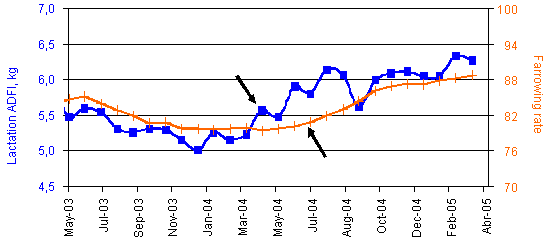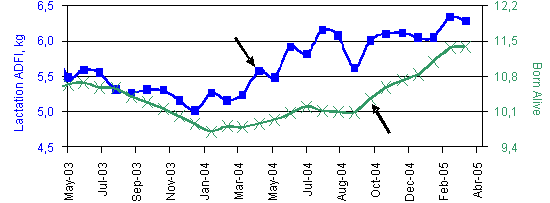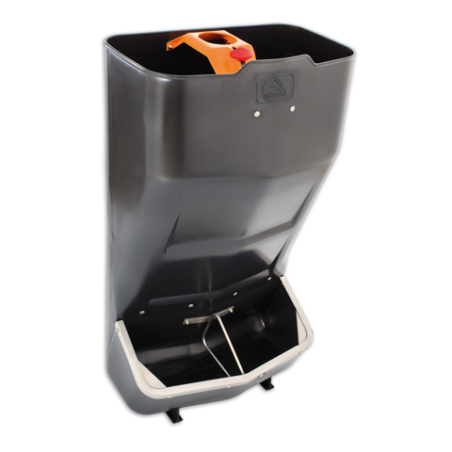This could be very shortly summarized by ‘’Start high and increase fast’’. A good principle is to ensure that the feed allowance, the day after farrowing, resumes to the same amount fed during the last 14 days of gestation: feed allowances should be at least 2.5 kg but we regularly see sows eating 3 to 4 kg the day after parturition in situations where dry sow feeding is well controlled and the sows are in good condition (no overweight). The amount of feed offered daily should rapidly increase in the following days by at least 0.5 kg/day and ideally by 1.0 to 1.5 kg/day. Research has repeatedly shown that too restrictive feeding patterns in early lactation (to prevent udder congestion, hypogalactia, piglet scouring, sow constipation and off feed events) can reduce total lactation feed intake for two reasons:
- Feed intake in the last thee weeks of lactation is not influenced by the intake in early lactation; and
- The lost feed intake opportunities of early lactation cannot be recuperated in the later stages of lactation (Quiniou et al., 1998; Aherne, 2001; Quiniou et al., 2000; Noblet et al., 1998).
Finally, large surveys have demonstrated that 30-35% show a marked dip in feed intake for 2-3 days in the second week of lactation, while 30% of sows show no feed refusals at all (Aherne, 2001). Therefore, it is better to tailor our feeding management toward the 2/3 of sows which do not show a marked drop in intake and target appropriate management strategies for those sows that do refuse feed, rather than the other way round. If a sow reduces or stops feeding 1 meal or 1 day, check vitals signs (temperature, udder state, etc…), empty feeder when necessary and resume as soon as possible to the amount distributed the day preceding feed refusal.

The amount of feed fed daily should be captured using a feed budget card, clothe pins clipped on the crate or feeder or any other system to track daily feed intake (Goodband et al., 2006). This also improves communication and coordination between different workers.
Sows should always be given enough time to eat; there is no hurry as they are hourly milking a litter of 10-12 piglets. It is preferable to distribute 2 to 3 meals daily at equal time intervals. Feeding as gruel by adding water stimulates intake by 3 to 12% (Quiniou et al., 1998; Genest and D’Allaire, 1995) but we should not add too much water as this could lead to feed wastage and too much dilution of the feed as well as possible fermentation and hygiene problems. There must be feed available in the feeder during most time of the day but feeders must be kept clean. These practices are referred to as ‘’feed to appetite’’ which should be as close as possible to ‘’ad libitum’’ feeding. According to KSU, as soon as 20% of feeders are empty at any given time during lactation, the sows are restricted at the producer’s will (Tokach, 2002).
Conclusions
Successful feeding management of sows during lactation could be summarized as ‘’maximize feed intake’’. Positive consequences of maximizing lactation intakes on lean and prolific genotype including improved wean to service interval, farrowing rate and subsequent litter size, have been observed in numerous research and commercial production systems (Figure 5 and 6). It looks simple but in reality it is a daily challenge. Sometimes it is necessary to overcome some inherent ‘’belief’’ that limits change by applying sound science to practical problems. Attention to dry sow feeding, management during lactation, ambient temperature, water, equipment and people will lead to success.

Figure 5. Relationship between lactation feed intake and farrowing rate (Goodband et al., 2006)

Figura igure 6. Relationship between lactation feed intake and subsequent born alive. (Goodband et al., 2006)




